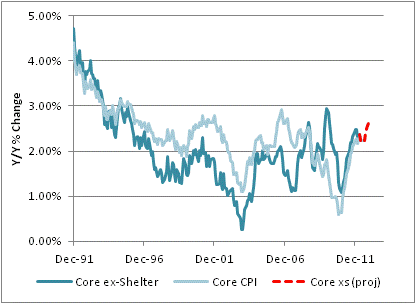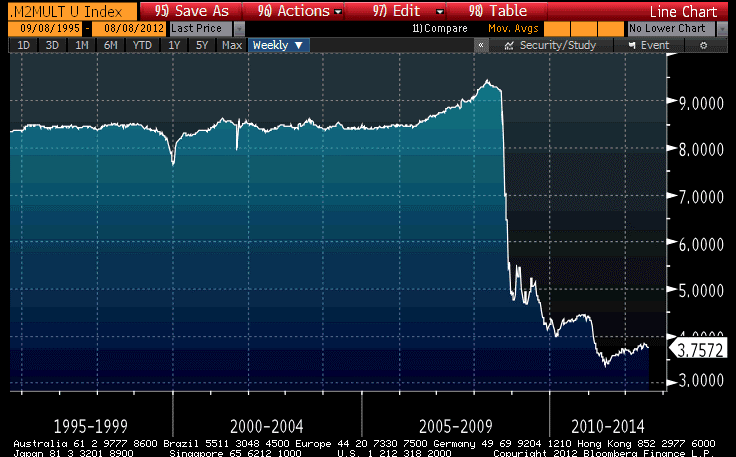While the markets are relatively quiet – bond yields rose slightly today and stocks were essentially flat; only commodities were reasonably buoyant – it may be a good time to examine the case for an acceleration of inflation and the risks to that case.
Inflation does not derive from excessive growth, nor deflation from excessive slack. While certain goods and services may experience relative price increases or decreases due to the microeconomic conditions of supply and demand, there aren’t any convincing examples of that happening for “aggregate” supply and demand in the absence of accommodating money supply growth. The clearest counterexample to the notion that growth and inflation are intimately interrelated is that in the period just past, the greatest recession in almost a century, year-on-year core inflation never declined, and if we remove the effect of the deflating bubble in housing, core prices in the rest of the economy never increased less than 1.1% on a year-on-year basis (see Chart, Source: Enduring Investments).
Nor is the expansion or contraction of the monetary base the key element in inflation. At one time, when the money multiplier that maps base money into transactional money (e.g., M2) was relatively stable, it didn’t matter if one used the monetary base – it was incorrect, but the relationship was stable so it didn’t matter. Once the Fed started paying interest on excess reserves, however, the relationship between base money and transactional money was artificially severed and it now matters which aggregate one uses. (See Chart, Source Bloomberg, which shows M2 divided by base money).
When the crisis hit, the velocity of money plunged as commercial bank lending dried up. The Federal Reserve properly countered this drop in velocity by pumping up the raw quantity of money. They did so in an awkward fashion; paying IOER meant the central bank had to add a lot more base money to cause M2 to rise appreciably, but it worked and prices as noted above never declined.
Now, commercial bank credit in the U.S. is expanding again, auguring a turn higher in money velocity in the near future. And yet, the Federal Reserve and other central banks continue to add money, setting up the potential for a long-tail inflation accident if velocity rebounds and the central banks do not begin to tighten in advance of that event. (I find that an extremely unlikely possibility, with Unemployment over 8% in the U.S. and no longer falling, and at least one Fed President calling for unlimited QE!) That doesn’t mean that we will get an inflation spike; in fact, year-on-year M2 growth is now under 7% here in the U.S. If money velocity doesn’t pick up, then core inflation may only rise slowly from here.
But all of that presumes a closed system where only the U.S. central bank affects the money supply that matters. Unfortunately, or perhaps fortunately, that isn’t the case. Inflation is substantially a global phenomenon, and here lies the potential for both optimism and pessimism on inflation.
On the pessimistic side, one must note that even if the Fed does not in fact pursue further QE, other central banks are sure to continue to do so. The Bank of Japan is not about to stop easing when core inflation in that nation remains below zero. The BOE continues to ease and the ECB has little choice but to ease further (or so they believe), and even the relatively responsible RBA is likely to keep money easy with China’s slowdown threatening on its doorstep. More money, all else equal, means more global inflation, and more global inflation – unless the U.S. dollar undertakes a serious and extensive appreciation – means more domestic inflation.
But on the optimistic side – for inflation, anyway – European money velocity may be on the verge of collapsing. If you want to make a case for slowing U.S. inflation, I do not believe you can look to the U.S., but rather must look to Europe. If domestic lending (and hence velocity) is rising partly because European lending (and velocity) is contracting, then some of the inflation potential is being sucked out, at least temporarily, by financial and credit strains in Europe.
In my view, the only plausible way we get appreciably lower inflation is if central banks abruptly stop quantitative easing (I don’t think there’s any measurable chance that they tighten) and the velocity of money in Europe (and Japan) drops faster than the velocity of money in the U.S. rises. In fact, I can make up a deflationary scenario, in which U.S. velocity rolls back over – perhaps because of some unforeseen consequence of the Volcker and conflict-of-interest rules, which some believe may impair securitization markets if the regulators don’t clarify certain issues – and central banks actually choose that moment to swear off QE. It’s very unlikely – mainly because I don’t think central banks will ever do more than pretend to care about inflation, and will keep on adding QE until inflation is not just a danger, but actually high enough that it becomes considered a bigger problem than persistently high unemployment.
However, if I’m wrong, I think the ‘optimistic’ (in a sense) scenario above is how mild disinflation could come to pass.
- English (UK)
- English (India)
- English (Canada)
- English (Australia)
- English (South Africa)
- English (Philippines)
- English (Nigeria)
- Deutsch
- Español (España)
- Español (México)
- Français
- Italiano
- Nederlands
- Português (Portugal)
- Polski
- Português (Brasil)
- Русский
- Türkçe
- العربية
- Ελληνικά
- Svenska
- Suomi
- עברית
- 日本語
- 한국어
- 简体中文
- 繁體中文
- Bahasa Indonesia
- Bahasa Melayu
- ไทย
- Tiếng Việt
- हिंदी
How Disinflation Could Happen
Published 08/10/2012, 01:15 AM
Updated 02/22/2024, 09:00 AM
How Disinflation Could Happen
Latest comments
Install Our App
Risk Disclosure: Trading in financial instruments and/or cryptocurrencies involves high risks including the risk of losing some, or all, of your investment amount, and may not be suitable for all investors. Prices of cryptocurrencies are extremely volatile and may be affected by external factors such as financial, regulatory or political events. Trading on margin increases the financial risks.
Before deciding to trade in financial instrument or cryptocurrencies you should be fully informed of the risks and costs associated with trading the financial markets, carefully consider your investment objectives, level of experience, and risk appetite, and seek professional advice where needed.
Fusion Media would like to remind you that the data contained in this website is not necessarily real-time nor accurate. The data and prices on the website are not necessarily provided by any market or exchange, but may be provided by market makers, and so prices may not be accurate and may differ from the actual price at any given market, meaning prices are indicative and not appropriate for trading purposes. Fusion Media and any provider of the data contained in this website will not accept liability for any loss or damage as a result of your trading, or your reliance on the information contained within this website.
It is prohibited to use, store, reproduce, display, modify, transmit or distribute the data contained in this website without the explicit prior written permission of Fusion Media and/or the data provider. All intellectual property rights are reserved by the providers and/or the exchange providing the data contained in this website.
Fusion Media may be compensated by the advertisers that appear on the website, based on your interaction with the advertisements or advertisers.
Before deciding to trade in financial instrument or cryptocurrencies you should be fully informed of the risks and costs associated with trading the financial markets, carefully consider your investment objectives, level of experience, and risk appetite, and seek professional advice where needed.
Fusion Media would like to remind you that the data contained in this website is not necessarily real-time nor accurate. The data and prices on the website are not necessarily provided by any market or exchange, but may be provided by market makers, and so prices may not be accurate and may differ from the actual price at any given market, meaning prices are indicative and not appropriate for trading purposes. Fusion Media and any provider of the data contained in this website will not accept liability for any loss or damage as a result of your trading, or your reliance on the information contained within this website.
It is prohibited to use, store, reproduce, display, modify, transmit or distribute the data contained in this website without the explicit prior written permission of Fusion Media and/or the data provider. All intellectual property rights are reserved by the providers and/or the exchange providing the data contained in this website.
Fusion Media may be compensated by the advertisers that appear on the website, based on your interaction with the advertisements or advertisers.
© 2007-2024 - Fusion Media Limited. All Rights Reserved.
